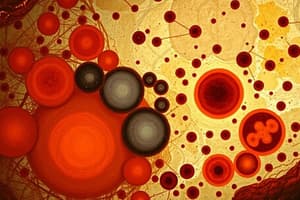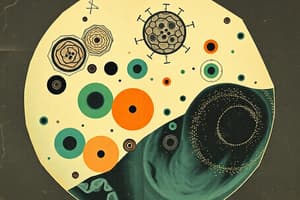Podcast
Questions and Answers
What is the function of the cytoplasm?
What is the function of the cytoplasm?
Holds organelles, many chemical reactions happen here.
What do microtubules and microfilaments provide for the cell?
What do microtubules and microfilaments provide for the cell?
Structural support
What is the structure of a vesicle?
What is the structure of a vesicle?
Sacs of membrane
What does the nucleus store?
What does the nucleus store?
What is the primary function of ribosomes?
What is the primary function of ribosomes?
What does a vacuole store?
What does a vacuole store?
What is the structure of the cell membrane?
What is the structure of the cell membrane?
What is the function of mitochondria?
What is the function of mitochondria?
What are cilia primarily used for?
What are cilia primarily used for?
What do centrioles help with during cell division?
What do centrioles help with during cell division?
What is the difference between rough ER and smooth ER?
What is the difference between rough ER and smooth ER?
Which organelles are present in both plant and animal cells?
Which organelles are present in both plant and animal cells?
Which of the following structures is unique to plant cells?
Which of the following structures is unique to plant cells?
Animal cells have chloroplasts.
Animal cells have chloroplasts.
Bacterial cells have a nucleus.
Bacterial cells have a nucleus.
What are plasmodesmata?
What are plasmodesmata?
What is the function of the nucleolus?
What is the function of the nucleolus?
Flashcards are hidden until you start studying
Study Notes
Organelles
- Cytoplasm is the watery filling of the cell that holds organelles and is where many chemical reactions happen.
- Microtubules and Microfilaments are tiny tubules and fibers that provide structural support for the cell.
- Vesicles are sacs of membrane that package and ship out proteins made at the ribosomes to the membrane.
- Nucleus is a membrane that stores DNA and contains the nucleolus. Its function is to store DNA that codes for specific traits.
- Nucleolus is a small dark, round to oval structure that produces ribosomes.
- Ribosomes are tiny organelles with no membrane. They produce proteins based on DNA instructions.
- Vacuoles are membrane structures that store food and water.
- Cell Membrane is a double layer bilayer made up of phospholipids, fatty acid tails, proteins, and cholesterol that allows materials to enter and exit a cell.
- Endoplasmic Reticulum (ER) is a membrane that contains enzymes. The enzymes do hydrolysis to break down waste and digest food.
- Mitochondria have two membranes with the inner membrane folded up. They produce energy (ATP) by doing cell respiration using glucose making ATP (energy).
- Cilia are tiny hair-like projections made up of microtubules that provide movement.
- Centrioles are small tubes made of microtubules that create microtubule spindle fibers that help divide chromosomes during mitosis and meiosis.
Difference between Rough ER and Smooth ER
- Rough ER has ribosomes attached and makes proteins that are shipped out of the cell by another organelle.
- Smooth ER has no ribosomes and detoxifies the cell and produces lipids.
Plant Cell vs. Animal Cell
- Similarities: Both have cytoplasm, cell membrane, ribosomes, ER, Golgi, mitochondria and nucleus.
- Differences:
- Plant Cells have a cell wall, large central vacuole (stores water), chloroplast, and plasmodesmata.
- Animal Cells have a flagellum (used to help the cell move).
Bacterial Cell vs. Plant and Animal Cell
- Similarities: All have a cell membrane.
- Differences:
- Bacteria have a different cell wall (cellulose in plants, peptidoglycan in bacteria, chitin layer in fungi), no nucleus, but a region containing DNA called the nucleoid, smaller ribosomes, no membrane-bound organelles, and may have plasmids.
- Plant and Animal Cells have a nucleus and membrane-bound organelles.
Studying That Suits You
Use AI to generate personalized quizzes and flashcards to suit your learning preferences.



